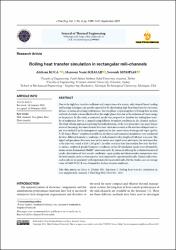| dc.contributor.author | Koca, Aliihsan | |
| dc.contributor.author | Khalaji, Mansour Nasiri | |
| dc.contributor.author | Sepahyar, Soroush | |
| dc.date.accessioned | 2021-09-20T11:25:12Z | |
| dc.date.available | 2021-09-20T11:25:12Z | |
| dc.date.issued | 2021 | en_US |
| dc.identifier.citation | KOCA, Aliihsan, Mansour Nasiri KHALAJI & Soroush SEPAHYAR. "Boiling Heat Transfer Simulation in Rectangular Mili-Channels". Journal of Thermal Engineering, 7.6 (2021): 1432-1447. | en_US |
| dc.identifier.uri | https://dergipark.org.tr/en/download/article-file/1956159 | |
| dc.identifier.uri | https://hdl.handle.net/11352/3937 | |
| dc.description.abstract | Due to the high heat transfer coefficient and compactness of a system, mili-channel-based cooling
and heating techniques are greatly expected to be distributing high heat flux from the electronic
devices. In terms of cooling performance, the two-phase evaporating flow of boiling flow in mini
and mili-channels is more effective than the single-phase flow due to the inclusion of latent energy
in the process. In this study, a numerical model was proposed to simulate the boiling heat transfer
of multiphase flow in a channel using different boundary conditions in the channel surfaces.
The fluid volume approach regulating the hydrodynamics of the two-phase flow was used. Source
terms of the energy and mass transfer that were taken into account at the interface of liquid and vapor
were included in the management equations for the conservation of energy and vapor quality.
A 3D Ansys-Fluent© simulation model was developed and numerical simulations were conducted
for four different boundary conditions. A mili-channel with a length of 140 mm was used. The
liquid and gas phases that were used in the model were liquid water and vapor; the total mass flux
at the inlet was varied at 118–126 kg/m2s. In order to realize thin film annular flow over the boiler
surface, employed specific boundary conditions in the 3D simulation model were obtained by
means of one dimensional Matlab© simulation code. By means of utilizing the evaluated numerical
results, distribution of heat transfer coefficient, vapor quality and dimensionless temperature over
the heat transfer surfaces were reported and compared to experimental results. Numerically evaluated
results are in agreement with experimentally measured results. For the studies cases an average
value of 23600 W/m2.K was obtained for the heat transfer coefficient. | en_US |
| dc.language.iso | eng | en_US |
| dc.publisher | Yıldız Teknik Üniversitesi | en_US |
| dc.relation.isversionof | 10.18186/thermal.990803 | en_US |
| dc.rights | info:eu-repo/semantics/openAccess | en_US |
| dc.subject | Mili-Channel | en_US |
| dc.subject | Two-Phase Flow | en_US |
| dc.subject | Heat Transfer | en_US |
| dc.title | Boiling Heat Transfer Simulation in Rectangular Mili-Channels | en_US |
| dc.type | article | en_US |
| dc.relation.journal | Journal of Thermal Engineering | en_US |
| dc.contributor.department | FSM Vakıf Üniversitesi, Mühendislik Fakültesi, Biyomedikal Mühendisliği Bölümü | en_US |
| dc.contributor.authorID | https://orcid.org/ 0000-0002-6142-9201 | en_US |
| dc.contributor.authorID | https://orcid.org/ 0000-0003-3391-7598 | en_US |
| dc.contributor.authorID | https://orcid.org/ 0000-0002-2074-7350 | en_US |
| dc.identifier.volume | 7 | en_US |
| dc.identifier.issue | 6 | en_US |
| dc.identifier.startpage | 1432 | en_US |
| dc.identifier.endpage | 1447 | en_US |
| dc.relation.publicationcategory | Makale - Uluslararası Hakemli Dergi - Kurum Öğretim Elemanı | en_US |
| dc.contributor.institutionauthor | Koca, Aliihsan | |



















